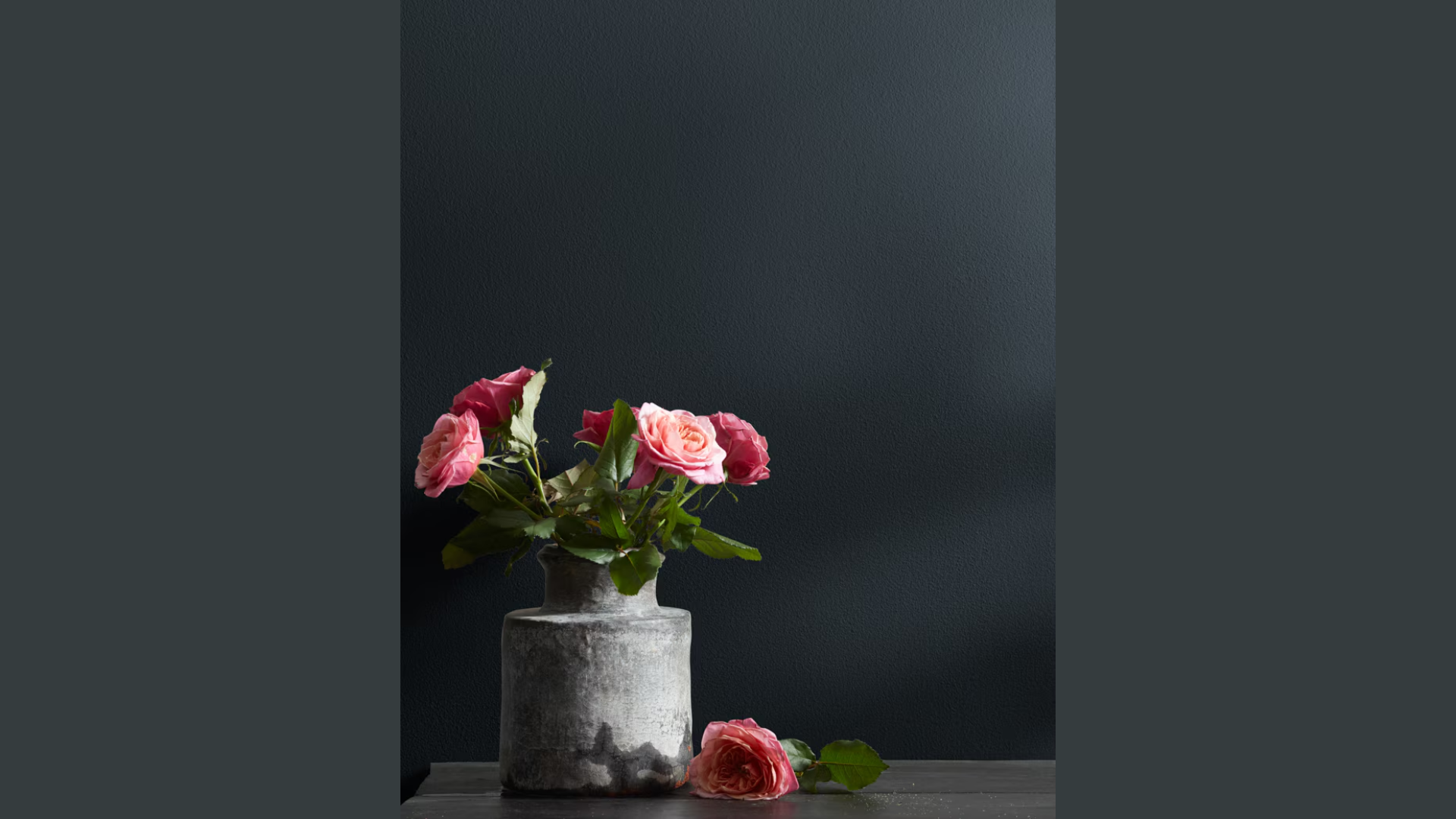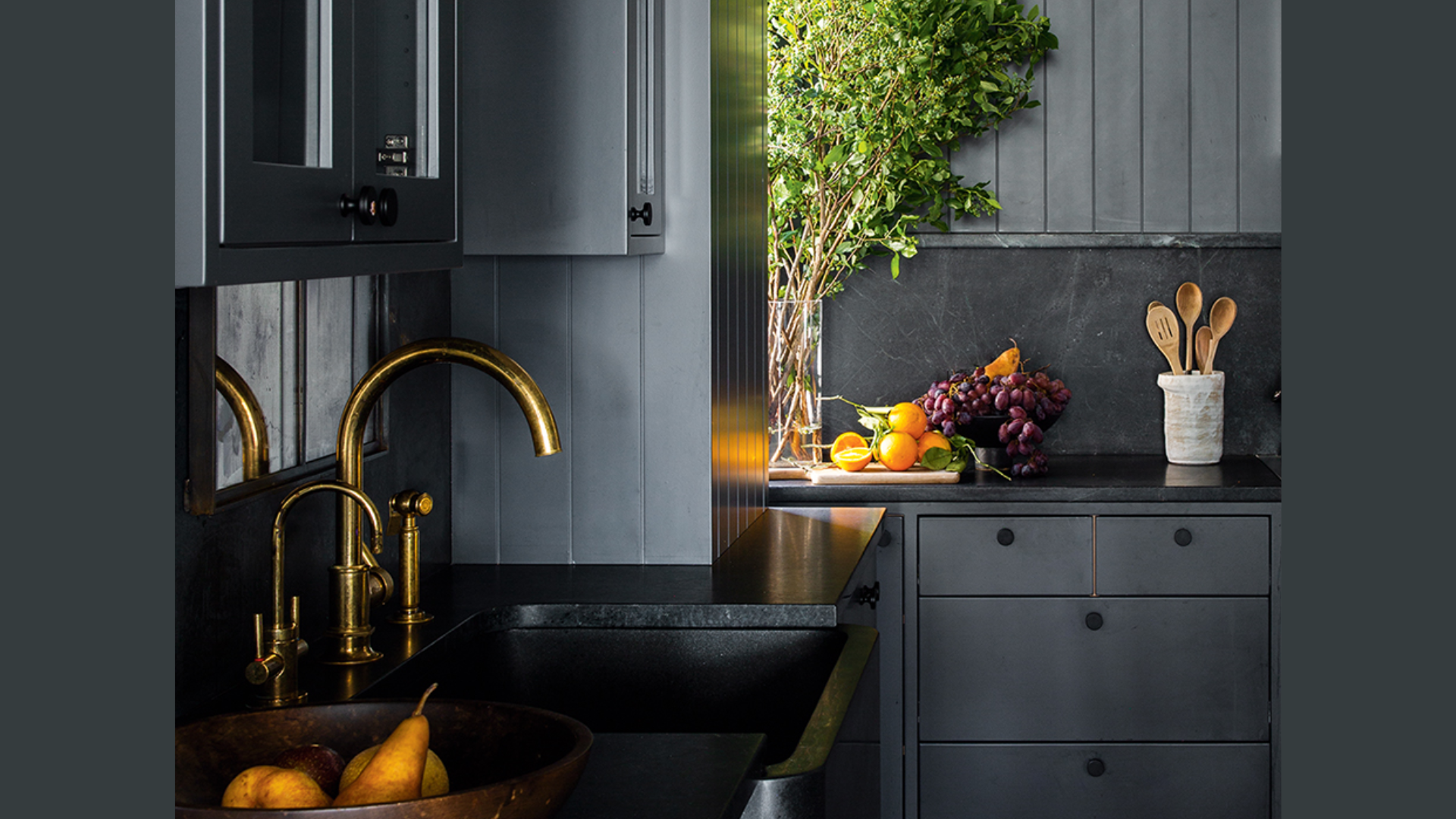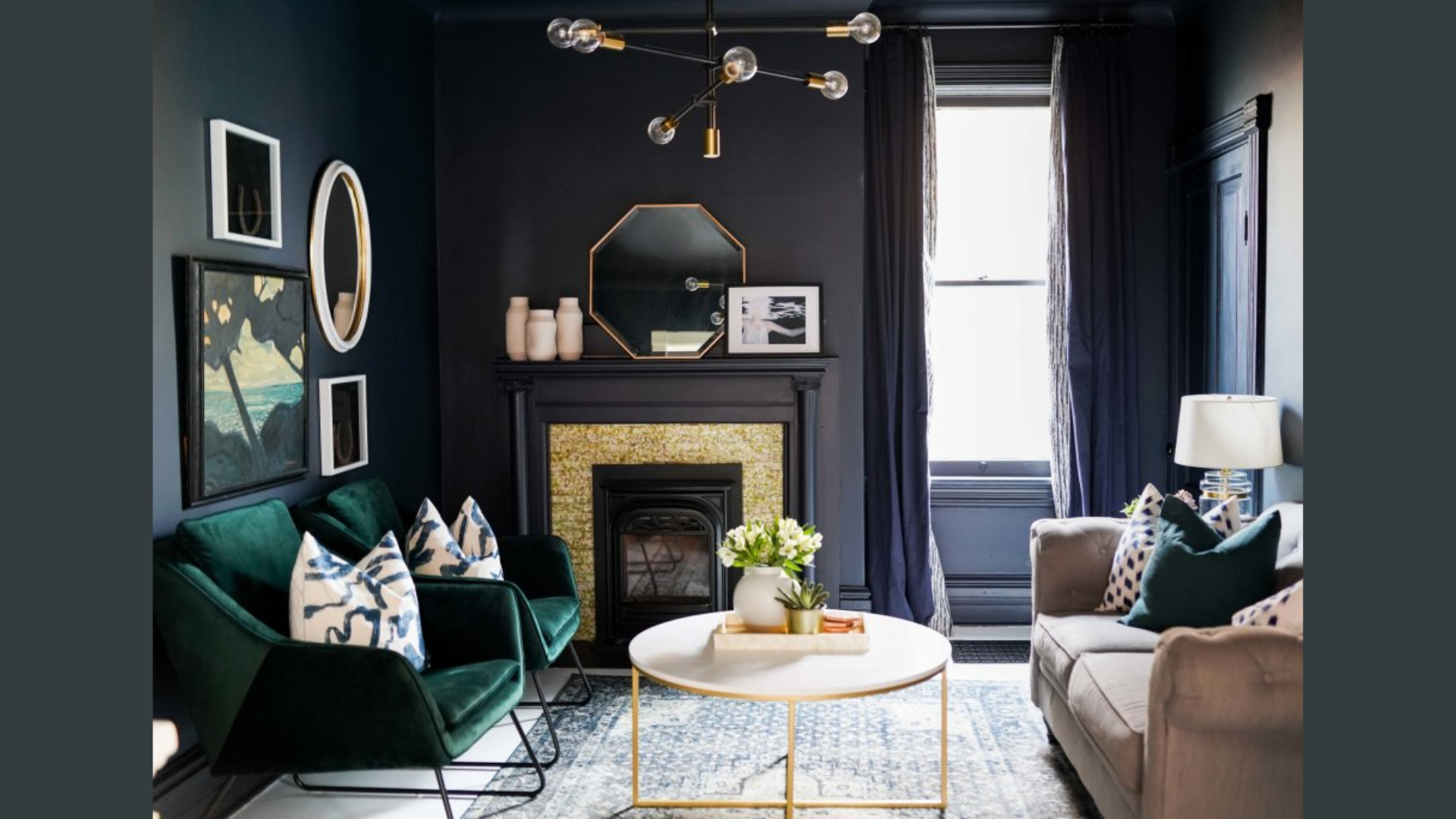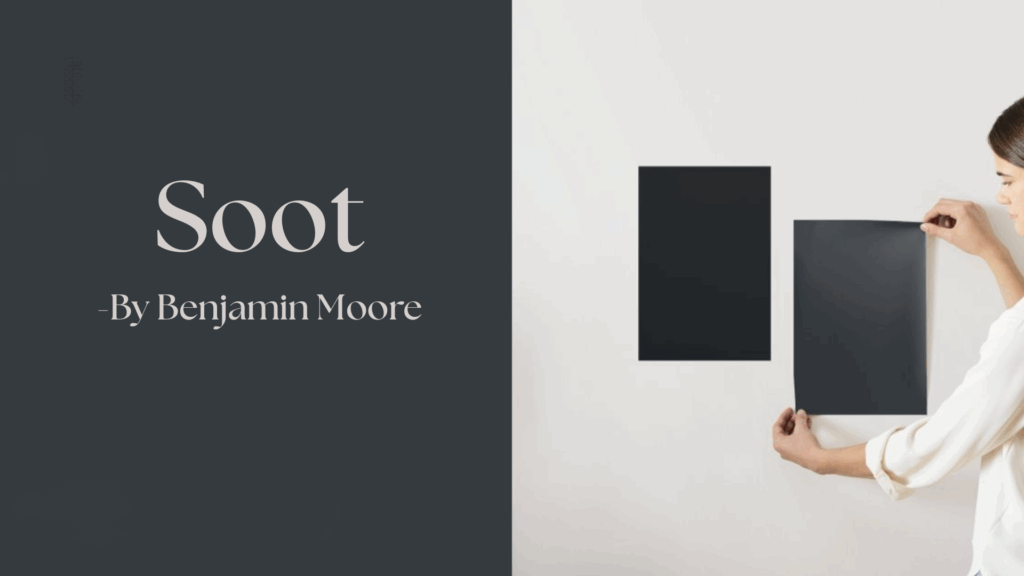Hi there! Today, we’re taking a close look at Benjamin Moore’s Soot (2129-20) – a deep, rich black with subtle blue undertones that’s capturing attention in homes everywhere.
Dark paint colors have become increasingly popular in recent years. Homeowners are drawn to their ability to create warm, cozy spaces while adding a touch of drama and beauty to any room.
I’ve seen Soot transform ordinary walls into striking focal points. What makes this shade stand out is its soft depth – not quite a true black, but darker than charcoal, giving it a unique character that works in both modern and traditional settings.
In this blog, you’ll learn:
- The best rooms and spaces for using Soot
- How to pair it with other colors
- Lighting considerations for dark paints
Let’s help you decide if this beloved dark shade is right for your home!
The Rich Undertones of Soot by Benjamin Moore

When I first saw Soot on a wall, I thought it was simply black. I was wrong. This paint color has hidden depths that make it special. Soot isn’t just black – it has gentle hints of blue and gray mixed in. These subtle tones give it a soft, layered look that plain black can’t match.
Soot has a Light Reflectance Value (LRV) of 6.19. What does that mean for you? It’s quite dark and absorbs most light that hits it.
But here’s where it gets interesting. In bright, natural daylight, you might notice those blue undertones more clearly. When evening comes and lamps turn on, the gray aspects might become more visible. The color shifts throughout the day! Your room’s furnishings also affect how Soot appears.
Put it next to warm woods, and it looks more neutral. Place it near cool whites, and those blue hints become more obvious. Why does this matter?
Understanding these color shifts is key before you commit. A paint that looks perfect in a store sample might feel completely different when it covers your walls. I always suggest testing Soot in your actual space.
Paint a large board and move it around the room at different times of day. Look at it next to your furniture, floors, and trim. This simple step can save you from paint regret later. The right dark color can transform your space – but only if you understand its true personality first.
The Psychology of Soot by Benjamin Moore
I’ve noticed something interesting when people walk into a room painted with Soot – they often pause and take a breath. This isn’t by chance. Dark colors like Soot affect us on a deep, emotional level. They wrap around us like a warm blanket on a cold night. They make us feel protected.
Colors speak to our minds without using words. When you use Soot in your home, you’re creating more than just a backdrop – you’re setting a mood. This deep shade helps build a sense of safety and comfort in living areas and bedrooms.
But that’s not all.
Soot also brings a natural sense of class to any space. I’ve seen it turn ordinary rooms into spaces that feel truly special. Think of fancy hotels or high-end restaurants – they often use dark colors to create that feeling of luxury. And here’s something you might not expect: dark walls can actually help you relax.
Unlike bright colors that wake up your brain, Soot’s deep tones can lower stress levels and help calm busy minds. Your choice of wall color shapes how people feel in a room. Want guests to feel welcome but also impressed? Soot might be your answer.
In small spaces, this dark shade can make walls seem to fade away, creating a cozy nest rather than a tiny box. What matters most is how you feel when surrounded by this color. Does it make you feel good? Does it match the mood you want for your space?
After all, your home should be a place that fits your emotional needs, and the right color can help make that happen.
Why Soot Is an Ideal Paint Color for Any Room?

I used to think dark colors were only for certain rooms. Then I saw Soot in action across an entire home. My mind changed completely.
Soot works nearly everywhere. In bedrooms, it creates a sleep-friendly cocoon that helps you drift off faster. In home offices, it builds focus and cuts down on distractions. For dining rooms, it sets the perfect mood for evening meals and good conversations.
But what about small spaces? Contrary to what many believe, Soot can make small rooms feel bigger, not smaller. When you paint all walls this deep shade, the corners seem to disappear, creating an illusion of endless space. Even exteriors benefit from Soot’s magic.
On front doors, window frames, or entire house exteriors, it creates a bold yet classic look that stands out from the neighbors without looking odd. This color somehow manages to be both dramatic and homey at the same time. It makes a statement without shouting for attention.
Now, let’s talk balance.
Too much darkness can feel heavy. I always suggest mixing in light elements when using Soot. Here’s how:
- Add light-colored rugs, especially ones with simple patterns
- Choose furniture in cream, tan, or light gray
- Hang mirrors to bounce whatever light you have
- Use metals like brass or chrome that reflect light
Your artwork will pop against the Soot walls like stars in a night sky. Pictures that seemed boring on white walls suddenly become focal points worth noticing. Plants also look nice against this backdrop. Their natural greens stand out in beautiful contrast.
The key is finding the right mix of light and dark in your space. Soot provides the perfect canvas—you just need to add the right touches to make it feel balanced and welcoming.
Best Places to Use Soot in Your Home
I’ve seen Soot transform ordinary spaces into something special. This color has a way of making rooms feel intentional and well-designed. Let me share my favorite spots to use this versatile shade in your home.
1. Bedroom

Your bedroom should feel like a retreat from the world. Soot creates walls that seem to hug you at night. I painted my guest bedroom with Soot last year. The change was immediate. The space went from plain to peaceful in just two coats. My guests now tell me they sleep better in that room than in their own homes!
For best results, pair Soot walls with crisp white bedding. The contrast makes your bed the focal point. Add natural wood nightstands and some green plants to bring life to the space.
Consider this: Paint just the wall behind your bed with Soot for a less intense effect. This accent wall approach still gives you the drama without committing to a fully dark room.
2. Kitchen

Kitchens with Soot can look remarkably current without trying too hard. I was skeptical about dark colors in kitchens until I saw my friend’s Soot cabinets. Her kitchen now feels like it belongs in a home design magazine. The matte finish on the cabinets looks especially nice with simple brass handles.
If full Soot cabinets feel too much, try just the lower cabinets. Keep upper cabinets white for balance. Or paint a kitchen island in Soot while leaving the rest light.
White countertops and backsplash tiles look clean and bright against this deep background. The contrast helps your kitchen feel balanced rather than gloomy.
3. Living Room

The living room is where you spend most of your waking hours at home. Using Soot here makes a bold statement. I love how this color makes TV screens less obvious when turned off. The dark wall helps your television blend in rather than dominate the room.
Your art collection will stand out like never before against Soot walls. Even simple prints suddenly look museum-worthy. For a living room with Soot walls, choose furniture in lighter shades. Cream sofas, tan leather chairs, or light wood tables create needed contrast. Add texture through throw pillows, woven baskets, and soft rugs.
Light matters here. Make sure you have enough lamps scattered throughout the space. Good lighting keeps the room feeling warm rather than cave-like in the evenings.
Flooring Options That Pair Beautifully with Soot
I’ve found that the right flooring can make or break a room painted with Soot. Your floor choice sets the foundation for how the deep wall color will feel in your space.
1. Light Wood Floors
Oak, maple, or ash floors create a beautiful contrast against Soot walls. This pairing is one of my favorites. I renovated my study last year using Soot with light oak floors. The contrast makes the room feel balanced and bright despite the dark walls. The light wood reflects available light upward, keeping the space from feeling too heavy.
This combination works especially well in rooms that get plenty of natural light. Morning sun bounces off the pale wood, creating a warm glow throughout the space.
Try this: If you’re working with existing dark floors but want this lighter look, a large area rug in cream or beige can create a similar effect without replacing your flooring.
2. Dark Wood Floors
Walnut, mahogany, or dark-stained oak create a rich, enveloping feeling when paired with Soot. I was worried my friend’s choice to pair Soot walls with dark walnut floors would make her dining room too cave-like. I was wrong. The space feels like an upscale restaurant – perfect for dinner parties and special occasions.
The key is to add plenty of light elements elsewhere. White trim, light curtains, and metallic accessories keep the space from feeling too dark.
This pairing works well in formal spaces or rooms where you want a sense of comfort and luxury.
3. Neutral Carpets and Rugs
Soft, pale carpets create a welcome contrast to bold, Soot walls. My bedroom features wall-to-wall carpet in a warm beige tone against Soot walls. The soft flooring makes the space feel cozy rather than stark. The carpet’s light color keeps the room from feeling closed in.
For hard floors, consider adding area rugs in cream, tan, or pale gray. These lighter tones help balance the darkness of the walls while adding comfort underfoot.
Texture matters here. Look for carpets with subtle patterns or varied pile heights to add visual interest without competing with your bold wall color.
4. Natural Stone and Tile
Marble, limestone, or concrete floors pair surprisingly well with Soot walls. I was stunned by how beautiful my neighbor’s bathroom looked with Soot walls against white marble floors. The natural veining in the stone pulled the whole room together.
For kitchens and bathrooms, light-colored tile creates a clean, fresh look against Soot walls. Even simple white subway tile takes on a new level when set against this deep background.
Natural stone in mid-tones like limestone or travertine creates a timeless, grounded feel that works well in entryways and living spaces.
Soot Compared to Other Paints of Benjamin Moore
I’ve tested many dark Benjamin Moore colors over the years. Each has its own character and best uses. Let me show you how Soot stacks up against other popular dark shades in a simple comparison table.
| Paint Color | Description | Undertones | Best For | When To Choose It |
|---|---|---|---|---|
| Soot | A soft black with depth | Blue-gray | Bedrooms, feature walls, and cabinets | When you want a rich black that doesn’t feel harsh |
| Wrought Iron | A softer charcoal | Blue-green | Exteriors, trim, doors | When Soot feels too dark, but you still want depth |
| Onyx | A true black | Neutral | Modern spaces, doors, and furniture | When you want the darkest option with minimal undertones |
| Kendall Charcoal | A mid-tone gray | Warm brown | Living rooms, offices, all-over color | When you want something dark but not black |
What makes Soot stand out? I find it has more character than Onyx (which can feel flat) but is deeper than Wrought Iron. The blue undertones in Soot give it a special quality that changes subtly throughout the day.
You might prefer Soot when:
- Your room gets plenty of natural light
- You want a black that feels soft rather than stark
- Your decor includes blues, grays, or cooler tones
- You need a dark color that works in both modern and traditional settings
Your lighting and existing decor should guide your final choice. What looks perfect in my home might look different in yours due to light conditions and surrounding colors.
Conclusion
After looking at Soot from every angle, I can honestly say it’s one of Benjamin Moore’s most useful dark colors. Its blue-gray undertones give it more personality than a plain black while keeping it neutral enough to work in any room.
The true test happens in your own space. I strongly suggest buying a sample pot and painting a large board with Soot. Move this board around your home at different times of day. Watch how morning light, afternoon sun, and evening lamps change its character.
Dark colors like Soot might seem scary at first. But I’ve found they often create the most comfortable and interesting spaces in a home.
When used with thought and balance, Soot doesn’t close in a room—it frames your life and makes everyday moments feel more special. It could be the perfect bold choice your home has been waiting for.

